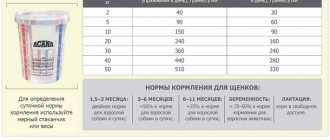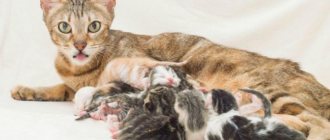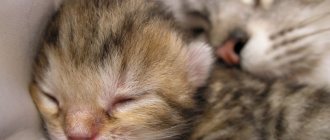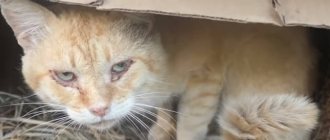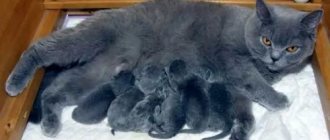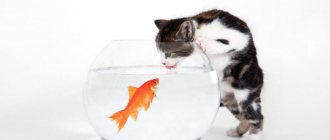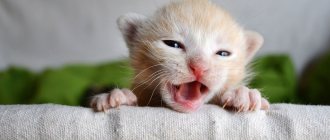The health and well-being of pets depends on compliance with the norm of cat food. Failures in food intake can lead to pathological conditions - anorexia or obesity, lead to metabolic disorders and a decline in immunity. Feeding rates vary depending on the breed of the cat, its weight and activity. Healthy feeding rules will help avoid diseases and ensure the normal development of the animal.
Natural food for cats
Many owners choose “natural”. It's tasty and healthy. However, do not forget that when choosing natural food, the owner bears increased responsibility for calculating the correct diet. A mistake can result in illness.
Some are convinced that the cat itself knows the right amount of food. This is far from true. Many purrs are ready to eat constantly. The result of such incontinence is excess weight, breathing problems and other ailments.
The diet for a kitten (from 10 weeks to 9 months) can be calculated using the following formula:
| Kitten weight X 10% = Daily diet volume |
That is, a kitten weighing 2.5 kg should eat approximately 250 grams of food per day.
Fermented milk products should make up ½ of the diet. Another ½ comes from meat.
The volume of the diet for an adult cat is calculated based on another formula:
| Cat's weight X 5% = Daily diet volume |
That is, a cat weighing 5 kg should eat 250 grams of food per day. This could be 130 grams of fermented milk food and 120 grams of meat.
You can add 10 - 15 grams of vegetables per day and 2 - 5 drops of oil.
You can weigh a cat as follows: first step on the scale yourself, then with the pet in your arms. The difference between the two numbers will be the body weight of your furry friend.
If you're a calorie-counting enthusiast, you can do the same for your cat. A kitten and teenager need more energy (838 kJ) than an adult cat (353 kJ). As for overweight animals, they need a maximum of 251 kJ of calories per day.
Feeding cats
Feeding is carried out naturally. The owner either prepares the food himself or uses suitable commercially available semi-finished products. The latter is considered the most favorable. It is necessary to accustom cats to a variety of foods when they are still kittens.
- Remember! You should not feed your cat the same dishes often, as it relatively easily gets used to monotony in its diet. If you constantly give your cat only one type of food - the one that she eats especially willingly, then it is likely that she will refuse other food. And this can easily lead to illness, since it has been scientifically proven that cats who enjoy the freedom to choose food do not always choose a diet that takes into account the body’s need for nutrients.
The amount of nutrition needed depends on a number of factors. Age plays an important role: young growing animals need more food than adults. The size of the body, weight, as well as the temperament and workload of the animal influence here. The latter can be understood as the biological load on the cat during the period of feeding kittens.
Environmental and maintenance conditions must not be ignored. It is not the same thing to keep an animal in a heated room or in a cold cage. Differences in content will primarily be expressed here in different amounts of feed. When preparing food, you need to remember that a cat needs a lot of protein. The ratio of proteins to carbohydrates, including non-digestible ballast substances, should be 2:1.
Weight
In adult cats, depending on the breed and gender, the weight is usually from 2.5 to 4.6 kilograms. However, many cats “step over” this line. It would be incorrect to calculate the daily ration of such animals based on “live” weight. It is excessive, and it is desirable that overweight cats, like overweight people, periodically step on the scales and lose weight to normal. It would not be harmful for the owner to get on the scales with the cat, because excess weight shortens the life of not only animals... ( Advice: You can weigh a cat like this: first weigh yourself with the cat, then weigh yourself and subtract your weight from the first.
)
Food requirement
An adult cat needs daily 100-150 grams of protein-containing food (meat, fish, eggs, cottage cheese, nutritional yeast, soy flour) and 50 grams of carbohydrate-containing additional food, including non-digestible ballast substances (oatmeal, cereals, rice, various vegetables - carrots, spinach, cauliflower, green beans and less acceptable greens).
The cat digests meat and fish normally in its raw form; It is better to boil or bake food containing carbohydrates, then its digestibility will increase, and by adding 5-10 grams of vegetable oil 2-3 times a week, you will cover the cat’s body’s deficiency in fatty acids (provided that the fat contained in the meat is will not be deleted, but will benefit the cat).
Eating
Here it should be taken into account that among cats, as among people, there are some individuals with poor appetite. More often we are talking about individual qualities that are not associated exclusively with the function of the digestive organs, but depend on metabolism. Due to castration, the metabolism often changes and the need for food is reduced.
Typically, a purebred cat is handed over to a new owner at the age of 10 weeks. The one who sells must inform the new owner about the basic rules of keeping and feeding. It is especially important to know the composition of food and how often to feed. Good owners who are interested in the normal development and health of the kittens sold to them always have a memo that contains the main numbers and dates. Naturally, the information about food contained in the written manual given to the new owner must correspond to the food actually given in the owner’s house, and not just be a “wish”.
At the age of 10 weeks, meals should be 4-5 times a day and range from 120 to 150 grams per day. Keeping in mind the increased growth of the animal, you need to take care of the rich protein content and mineralization (calcium) of the food. By 4 months, cats already need the same amount of food that an adult animal needs. The number of meals should be 4 for now. In the 5th month, we reduce the number of meals to 3 per day, and in the 7th month - to 2.
Number of meals
It is up to the owner to choose how many times a day to feed the cat: once or twice. It will not be harmful and in no case a mockery of the animal if you feed it the entire daily portion in the evening. Experience shows that it is much healthier for a cat to eat this meat dinner than to survive on treats throughout the day, often consisting of products that are completely unsuitable for the animal, including chocolate. There should always be clean water near food.
The dishes from which a cat eats, naturally, should be different from those used by people. Firstly, for hygienic reasons, and secondly, the dishes are an optical signal telling the cat that this is where its food is located. Those who do not follow this rule should not be surprised if they see their beloved cat one day kissing the contents of their plate... A cat’s dishes should be as clean as ours.
There is another approach to feeding: the cat should get food when it wants. Perhaps this is several times a day. If this does not bother you and if your cat does not overeat, then in my opinion this approach is preferable. By the way, you can provide your cat with constant access to dry food (remember the water!), and then she can get enough whenever she wants.
Feeding time
You need to feed your cat at the same time every day. Her body gets used to this and includes meals in its daily rhythm. Free-ranging animals usually arrive at feeding time.
The food must be warm
Food that is hot or has just been taken out of the refrigerator is not suitable for your cat. Just like its predatory relative in the wild, our cat needs a secluded corner to eat. Any owner needs to take this into account.
Rest after eating
“After eating, a cat needs rest,” the cat always adheres to this motto. Digesting food is work for the body, and the cat does not like to be played with at this time. Respect this period of time, even if it is at the end of the day when you have free time. Although not all cats adhere to this rule. For example, my Schweika willingly plays immediately after eating.
Leftover food
You can't leave them in the dishes. In summer or in a hot room, protein foods spoil very quickly.
Calories
To calculate your cat's food needs, you need to use some simple calculations. Experts have calculated the food requirement for different ages, during pregnancy and feeding offspring - in kilojoules per 1 kilogram of body weight per day. Therefore, the former calculations in kilocalories had to be abandoned. But conversion from kilocalories to kilojoules is possible: just multiply the value in kilocalories by 4.19 and you get the result in kilojoules.
The energy requirement of a young cat (between 7 and 12 weeks) is 838 kJ. Growing and pregnant cats need 419 kJ. In adult animals, the energy requirement is reduced to 335.2 kJ. Lactating cats should receive 1047.4 kJ, and overfed and overweight cats should receive only 251.4 kJ until their weight returns to normal.
The calorie content is written on commercially available products or their number can be determined from tables in culinary reference books, so it will not be difficult for you to choose a certain amount of food for your cat.
Digestibility
We must not forget that the food offered to our cat is not always completely digestible. We must assume that digestibility is on average 75-80 percent. Take this into account when determining the amount of feed. On the other hand, we must not forget individual characteristics when evaluating food, which we have already discussed. At low temperatures and in extreme heat, the need for energy increases.
Traditional food
With it, you need to take the energy content from special tables and calculate calories on paper. Taking into account the ratios of proteins, carbohydrates and fats given on the Cat Nutrition page, you can achieve a suitable diet.
By nature, cats are not gourmet eaters, and the fact that they give preference to one or more dishes when it comes to food is not proof that it is truly beneficial for them. From an early age, it is necessary to accustom your cat to a varied diet, avoid feeding it the same food for a long time, and adhere to a balanced diet. This will help you avoid cat whims and raise your animal healthy.
It is believed that a cat requires 30-60 g of food per 1 kg of live weight per day. The weight of an adult animal is 2-4 kg. For those who like accurate information, here are approximate cat diets:
(g/kg live weight, components are crushed and mixed):
Menu 1
raw beef (fatty) - 20.0 raw liver - 10.0 boiled oat flakes - 4.0 vegetable oil - 0.2 dry yeast - 0.1 water - 10.0
Menu 2
raw beef heart - 20.0 raw lungs - 10.0 boiled rice - 4.0 cottage cheese - 3.0 dry yeast - 0.3 water - 7.0
Menu 3
raw fish - 30.0 raw liver - 5.0 boiled oat flakes - 4.0 vegetable oil - 2.0 dry yeast - 0.2 water - 4.0
Menu 4
raw fish - 20.0 cottage cheese -10.0 boiled oat flakes - 4.0 vegetable oil - 1.3 dry yeast - 0.2 water - 9.0
The dry yeast offered is, of course, brewer's yeast, not baker's. They are bought at the pharmacy as a vitamin preparation.
Here is also a sample menu for an overweight cat:
Menu 1
Morning.
40 g dairy products or special milk for cats.
Day.
100 g of boiled fat-free lung.
Evening.
20 g of industrial feed.
Menu 2
Morning.
75 g low-fat cottage cheese.
Day.
100 g minced meat.
Evening.
10 g of cereal and 2 teaspoons of vegetable puree.
Menu 3
Morning.
1 egg yolk and 1 teaspoon of ground sprouted wheat grains.
Day and evening.
150 g of boiled lean fish.
Feeding with commercial feed
Dry food.
Most cats readily eat these foods, especially if they are accustomed to it from an early age. Your veterinarian will recommend a specific diet for your cat. The main disadvantage of this type of food is the low amount of fat. Therefore, if your cat receives dry food, then it is necessary to add fats. In this case, you can use this type of food as the main one.
Soft food
It also makes sense to give it to a cat. It is somewhat more expensive than dry and also does not contain enough fat. Liquid ingredients, preservatives, and large amounts of sucrose can cause digestive upset in some cats. Therefore, this type of nutrition can only be recommended as an addition to the main one and must be used very carefully.
Canned food
are the most expensive, but also the most complete type of food. Canned food is usually made either from meat and meat products, or from cereals with the addition of vitamins and mineral salts and allows you to create a balanced and complete diet. Avoid canned food that contains large bone fragments or blood, as well as other indigestible materials, as this indicates poor quality food.
If your cat receives canned or dry food, carefully study the box or can for how to consume it.
- Remember! Feeding only
dry food is harmful to cats.
If your cat only eats dry food, you need to stop her from this habit as quickly as possible (see “Picky Eating”). If the above tips do not help, try resorting to a more effective remedy - two to three days of fasting. It won't hurt her ( remember the water!
).
Partially used information from the books “All about cats” ch. ed. Y. Tyra, N. Nepomnyashchy “Cats”, Nikishina E. “500 practical tips for cat owners” and G. Berbel “Cats”
Links on the topic "Nutrition"
- Cat food
- Commercial feed
- Picky eating
- Cat nutrition features
- Feeding aging cats
What to feed your cat
The following products can be included in the diet:
| Meat | It is better to choose lean beef or chicken. It is acceptable to use rabbit or lamb. Pork is strictly prohibited! The meat is given raw, but is first doused with boiling water. However, some cats prefer the boiled product. |
| Fish | Choose lean sea fish, clean it from bones, and boil it. However, you should not abuse “fish days”. Fish can be given once a week instead of meat. Fish should not be given to spayed or neutered male or female cats! |
| By-products | You can give your cat heart, lungs, liver or kidneys. However, keep in mind that their calorie content and healthiness are lower than that of meat. Offal is given raw, no more than 2 times a week. But these foods cause diarrhea and vomiting in many cats, so be careful. |
| Fermented milk products (kefir, cottage cheese, cheese, sour cream) | They should make up 50% of the cat's diet. Fat content should not exceed 9%. But low-fat ones are also not very healthy: they can lead to diarrhea. The cat's body does not digest milk well. |
| Vegetables | A cat can eat almost any vegetables: pumpkin, beets, carrots, cabbage, peppers. Focus on your pet's preferences. Vegetables are finely chopped, served raw or stewed in water, you can add oil. It is not recommended to give potatoes. |
| Eggs | Quail or chicken can be added to cottage cheese or kefir (1 piece per week). |
| Bran | Can replace vegetables, they are good for digestion. They are often mixed with meat or dairy products. |
| Oil | Flaxseed, pumpkin, vegetable, olive are added to food (no more than 5 drops), and have a beneficial effect on digestion. |
| Cereals | Hercules, rice can be given in small quantities in the form of porridge (meat broth or water). They are mixed with meat or fish. |
How to feed a cat: rules
To keep your cat not only well-fed, but also happy, you will have to adhere to a diet and follow some rules.
The frequency of feeding cats is as follows:
| Adult cat | 2 - 3 times a day |
| Kittens (up to 5 - 6 months) | 4 times a day |
| Spayed and neutered cats and female cats | 1 per day |
There should always be clean, fresh water in the bowl.
It is better to feed your pet at the same time. Routine is very important for a cat. It is better if feeding occurs during peak activity periods (for example, 8 and 18 hours).
Place the food bowl in a secluded place.
Food should be at room temperature, neither cold nor hot.
The cat should be able to chew its food comfortably. You should not give a large piece of meat. Remember that furries eat quickly, and a large bite can result in digestion problems or cause vomiting.
You need to feed your cat exclusively fresh food.
It is better to leave the meat for the evening.
Unfinished food should not be left in a bowl - it will spoil.
After eating, the cat usually sleeps. It's normal, don't bother her.
You should not feed your pet leftovers from family meals.
Your cat may need additional vitamins and minerals, as not all of them come from food. But before choosing them, consult your veterinarian.
Pet stores sell special grass for cats that you can grow at home. It is recommended to give sprouted greens every day.
If your cat does not eat or you notice frightening symptoms (diarrhea, vomiting, lethargy, fever), you should contact your veterinarian.
How often should I feed?
The amount of food consumed in cats' natural habitat varies from day to day, but pets receive food regularly. The peculiarities of living in an apartment leave an imprint on the diet, so the answer to the question of how much food a cat needs per day depends on a number of factors:
- the type of food given to the pet;
- age of the cat;
- cat body weight;
- breeds;
- pregnancy;
- whether the cat is castrated and whether the cat is sterilized;
- the presence of obesity, dystrophy in the pet.
The animal's diet changes if it is sterilized.
When preparing a diet, you should take into account that a portion of dry cat food takes longer to digest than canned food and pates, providing a long-lasting feeling of satiety. A serving of 30-55 grams of crunchy granules is equivalent to 170-220 grams of pouched food. Therefore, it is recommended to give granulated food 1-2 times a day, and divide the daily dose of wet food into 3-4 doses.
Premium segment products have lower consumption and saturate the cat more effectively, leaving a feeling of fullness for a long time.
Dry cat food
It is better to choose premium or super premium food. Also, when choosing, be guided by the pet’s age and state of health. For example, special food is sold for neutered cats. When calculating servings, follow the manufacturer's instructions on the package.
If you have chosen the right dry food, your cat likes it and she feels good, you should not change it without serious reasons.
The cat is gradually transferred to the new food, usually over two weeks. All this time, carefully monitor your pet’s well-being.
Is your cat eating properly?
If your cat is energetic, playful, moderately well-fed, and her coat is shiny and silky, then you are feeding her correctly.
Remember that as you age, your diet adjusts. Kittens need more minerals and protein.
After 7 years, the portion is reduced, the amount of protein is reduced slightly, as the cat becomes less active. As for an older cat, try to give smaller pieces and warm the food slightly (up to 35 degrees).
To be on the safe side, give your cat a blood test for biochemistry once every 1.5 years. This will determine if your cat is getting enough nutrients.
The proportion of meat and the protein content in feed are different things
To ensure your cat gets the right amount of animal protein, unlike most manufacturers, we use plenty of fresh meat, fish, poultry and eggs, without replacing them with processed animal meal or grain, a source of plant protein. Our Acana and Orijen foods contain up to 85% quality animal ingredients - this figure is printed on the front of the packaging and is hard to miss. It is important to understand that the volume of meat products is not equal to the volume of protein in the feed!
To understand how much protein is in our foods, you need to find information about this macronutrient in the “Guaranteed Analysis” section, which is on the back of each food package. Please note that the protein content is indicated in this case taking into account moisture, which in Akana and Orijen dry food is 10%. Following the formula, you can easily recalculate this indicator and find out how much protein will be in the dry residue. For example, Acana Pacifica food contains 37% protein, but if you take away the moisture, you get 41%.
37*100/(100-10) = 41%.**
